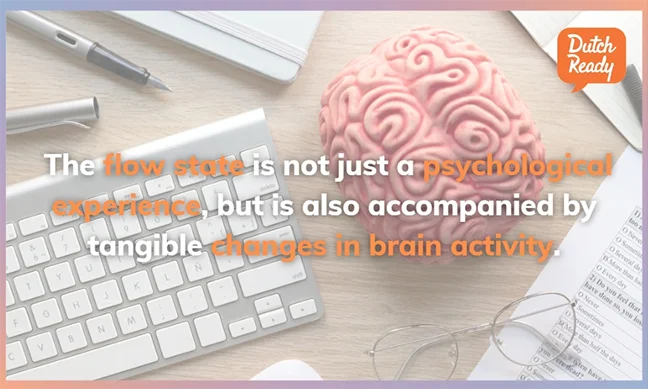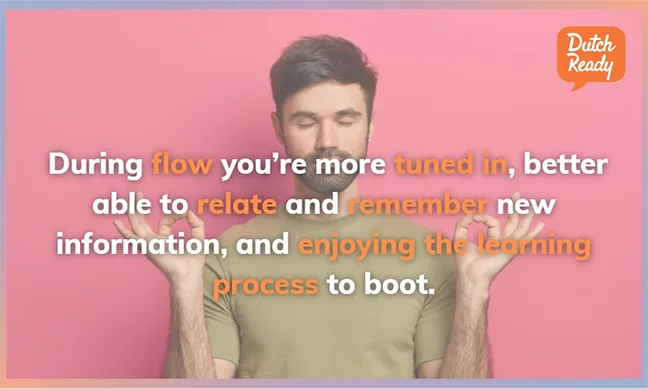

Optimal flow, also known as the “flow state,” is a state of peak performance in which an individual is fully immersed and focused on the task at hand. Research has shown that experiencing optimal flow can lead to increased productivity and motivation, as well as a deeper sense of satisfaction and enjoyment. In the realm of language learning, achieving the flow state can have significant benefits, including faster acquisition of new skills and a greater retention of information. By understanding how to enter and maintain the flow state, language learners can optimize their study sessions and ultimately improve their overall progress and success in learning a new language.
Optimal flow was first described in the 1970s by psychologist Mihaly Csikszentmihalyi. Csikszentmihalyi, a Fellow of the American Psychological Association and the American Academy of Arts and Sciences, has received numerous awards for his contributions to the field of psychology. The term optimal flow was recently brought back into the public eye with his book “Flow: The Psychology of Optimal Experience”.
Neuroscientific research has shown that the flow state is not just a psychological experience, but is also accompanied by tangible changes in brain activity such as:
In other words, during flow you’re more tuned in, better able to relate and remember new information, and enjoying the learning process to boot.

Image by Freepik
These neurophysiological changes can lead to improved learning and performance in a variety of tasks, including language learning (Nakamura & Csikszentmihalyi, 2014). For instance:
So, why does optimal flow lead to improved language learning? One reason may be that it allows learners to fully engage with the material, rather than becoming distracted or disengaged. Optimal flow can also increase motivation and persistence, leading to more consistent and dedicated practice.
Additionally, the flow state triggers many chemical changes in the brain that help create connections, retain information, and recall it again later. Which means that all that extra focus and motivation has an even bigger impact.
The state is characterized by a feeling of effortless concentration and enjoyment. No wonder individuals who experience optimal flow are more likely to engage in activities for longer periods of time and to perform at their best.

Image by wayhomestudio on Freepik.
To achieve a flow state in language learning, it is important to find an activity that is engaging and challenging, but not overly difficult. Ideally, the difficulty of what you are trying to learn is just outside your comfort zone. Meaning, it is still something you struggle with, but it isn’t so new or challenging that it’s overwhelming.
Is the material too easy? You’ll likely lose interest as your progress stalls. Make it too hard, and you’ll be likely to quit in frustration. In essence, you need to find the perfect balance between ease and difficulty, comfort and discomfort. By materials, by the way, we don’t necessarily mean a textbook. Did you know that creative activities are one of the proven tips to practice Dutch in daily life?
It is also important to set specific and achievable goals for the language learning session. A clear structure and a quiet, distraction-free environment can help focus your mind and facilitate flow. It may also be helpful to have a sense of control over the learning process, as well as immediate feedback on progress. With practice and patience, it is possible to enter a flow state and greatly improve language learning abilities.
Our private language lessons are the perfect place to enter the flow state. We customize the lessons to make sure they’re always at the right level, and focus on your own personal goals. Our patient tutors help structure the process and provide you with direct feedback during your speaking or writing. Interested in trying out private lessons? You can learn more or sign up right here.
Our private language lessons are the perfect place to enter the flow state. We customize the lessons to make sure they’re always at the right level, and focus on your own personal goals. Our patient tutors help structure the process and provide you with direct feedback during your speaking or writing. Interested in trying out private lessons? It will only take you a minute to sign up for a trial lesson Dutch.
Another option is our e-learning Dutch, which is currently available at levels A0-A1 and A1-A2. Our e-learning covers all the grammar you need to be fully prepared for language use in daily life and exams. The inductive and practical exercises make this self-study optimally engaging and the ideal tool for online learning tailored to your needs.
Scientific references in this article
We believe science-backed education is the future. Therefore we will always include links to the scientific research on which we base our methodology. The articles cited in this article are:
Dunlosky, J., & Metcalfe, J. (2013). Metacognition. Annual Review of Psychology, 64, 317-344.
Jackson, S. A., & Csikszentmihalyi, M. (1999). Flow in sports: The keys to optimal experiences and performances. Champaign, IL: Human Kinetics.
Jackson, S. A., Eklund, R., and Maier, M. (2013). Optimal experience in sport: A review of flow theory and its practical implications. International Review of Sport and Exercise Psychology, 6(1), 50-66.
Jung, Y., McNamara, T., & Magliano, J. (2010). Neuronal basis of flow experience during computer game play. Cyberpsychology, Behavior, and Social Networking, 13(2), 185-190.
Li, Y. (2003). The effects of flow experience on motivation and language learning outcomes. Journal of Educational Psychology, 95(4), 740-748.
MacIntyre, P. D., Clément, R., Dörnyei, Z., & Noels, K. A. (1998). Conceptualizing willingness to communicate in a L2: A situational model of L2 confidence and affiliation. Modern Language Journal, 82(4), 545-562.
Nakamura, J., & Csikszentmihalyi, M. (2014). The concept of flow. In Flow and the foundations of positive psychology (pp. 5-26). Springer Netherlands.
Tang, Y. Y., Ma, Y., Fan, Y., Feng, S., Lu, Q., Yu, Q., … Posner, M. I. (2015). Short-term meditation training improves attention and self-regulation. Proceedings of the National Academy of Sciences, 112(35), 10742-10747.
Want to learn Dutch fast? Check out our other blogs about effective language learning, like our blog article on how to study vocabulary effectively with spaced repetition or how to improve your Dutch pronunciation. You can also follow us on Instagram for mini lessons and more information on the Dutch language and culture.
Language lessons & materials designed to help you learn Dutch fast. Use what you know, simplify what you don’t.

Hi! We just wanted to let you know that we use cookies on our site. These cookies enhance your experience, improve the quality of our site, and help us show you things that are more likely to be relevant to you. You have the option to manually allow third parties (including our advertising partners) to enable cookies on our website. By clicking 'Accept', you're agreeing to the placement and use of cookies described in our Cookie Policy. That's all. Thanks for reading!